The Allure of One Carat Diamond Rings
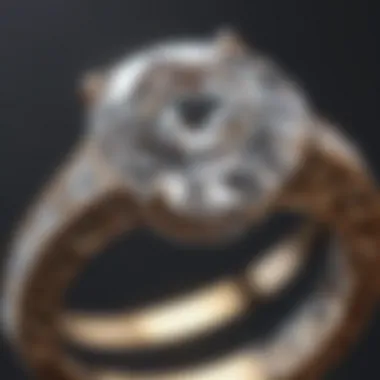
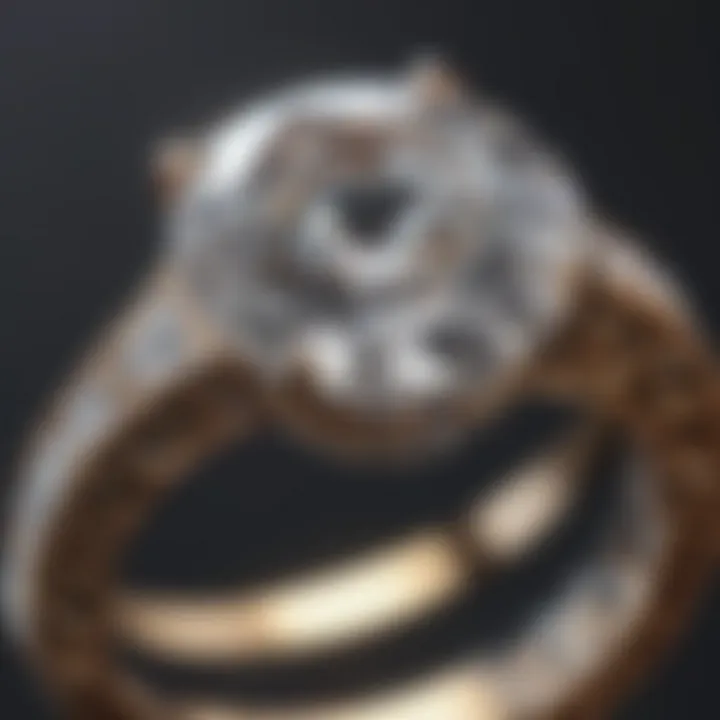
Intro
One carat diamond rings often symbolize an ideal blend of elegance and commitment. Their popularity spans generations, making them a significant choice for engagements and anniversaries alike. Understanding the allure behind these rings involves looking at their historical significance, the complexities of diamond grading, and the artistry in setting them.
The purpose of this article is to provide an in-depth exploration of one carat diamond rings for both collectors as well as casual admirers. By investigating their characteristics and nuances, readers will gain valuable insights into choosing and maintaining their own pieces.
Gemstone Overview
Definition of Gemstones
Gemstones are minerals that are cut, polished, and used in jewelry. When it comes to diamonds, their unique properties such as durability and light refraction make them one of the most sought-after gemstones in the world. A one carat diamond measures approximately 6.5 mm in diameter, making it a perfect size for creating statement pieces yet still subtle enough for daily wear.
Classification of Gemstones
Gemstones, including diamonds, can be classified based on several factors:
- Natural vs. Synthetic: Natural gemstones are mined from the earth, while synthetic ones are created in laboratories.
- Precious vs. Semi-Precious: Traditionally, diamonds, emeralds, rubies, and sapphires are considered precious, while other stones fall under the semi-precious category.
- Transparency: This refers to how light passes through the stone, with diamonds classified as transparent.
Historical Significance
Origins of Gemstone Use
The use of gemstones dates back to ancient times, serving not only decorative purposes but also protection and amulets for various cultures. Diamonds have a rich history, with their first recorded use in India around the 4th century BCE. The allure of diamonds started to grow, gradually becoming a symbol of wealth and power.
Cultural Insights: Gemstones in Ancient Civilizations
Throughout history, gemstones have held significance in various cultures:
- India: Diamonds were associated with royalty and divine favor.
- Greece and Rome: Used for both adornment and believed to possess protective qualities.
- Medieval Europe: Gems, including diamonds, were thought to represent virtues like courage and strength.
"Diamonds are not just stones; they are pieces of history and stories captured in crystal form."
Choosing a one carat diamond ring goes beyond aesthetics; it involves an understanding of its rich legacy.
Prelims to One Carat Diamond Rings
One carat diamond rings hold a special place in the world of gemstones. They represent a sweet spot between size and affordability, making them highly coveted for engagement rings and other significant jewelry pieces. These rings often embody emotion, elegance, and commitment. In this section, we explore the significance of one carat diamonds, focusing on their characteristics and the reasons they are valued.
A carat weight, equal to 200 milligrams, reflects a diamond's overall mass, but it also ties directly to its visual impact. A one carat diamond can have remarkable beauty when selected carefully based on the Four Cs: cut, clarity, color, and carat. This balance of size and quality aligns well with the desires of many buyers, as it provides an enticing blend of presence without being overwhelmingly large. Here, potential buyers must consider both their budget and expectations.
In addition to their aesthetic appeal, one carat diamond rings also hold sentimental value. They are often chosen for engagements to signify love and devotion. The journey towards selecting the perfect ring becomes a personal narrative that many cherish. Factors such as lifestyle, personal taste, and future maintenance play critical roles in decision-making. Thus, understanding the nuances involved in choosing a one carat diamond is essential.
Additionally, cultural significance surrounds diamond rings. In many societies, they symbolize commitment and are given as tokens of love, especially during proposals. The ritual of giving and receiving these rings connects people with tradition and personal meaning.
Ultimately, the one carat diamond ring serves as more than just a piece of jewelry. It embodies values and emotions. The choice to opt for a one carat diamond can reflect a thoughtful balance between practical considerations and romantic ideals.
"A one carat diamond often signifies the principles of love and commitment while being manageable for budgets. It's a favored option for many couples."
Historical Significance of Diamonds
Ancient Beliefs and Uses
Diamonds hold a deep-rooted place in various ancient cultures and hold numerous meanings. For the Romans, diamonds were believed to be splinters of stars that had fallen to Earth, bestowing them with celestial power. Similarly, in India, diamonds were thought to protect against evil spirits and were often utilized in ceremonial rituals. Ancient civilizations recognized their durability and brilliance, associating them with strength and purity.
The historical context surrounding diamonds underlines how these gemstones transcended mere adornment. They were revered as tokens of strength, purity, and even invincibility. Notably, the Ancient Greeks believed that diamonds were the tears of gods, a reflection of how culturally significant these stones became across various societies. Their desirability started much earlier than the modern engagement ring trend, establishing a heritage that modern consumers can connect to.
Evolution of Diamond Engagement Rings
The transition of diamonds into engagement rings is a narrative steeped in marketing, romance, and culture. The most pivotal moment came in the late 19th century, when Archduke Maximilian of Austria gifted a diamond ring to Mary of Burgundy. This marked one of the earliest recorded instances of a diamond engagement ring, setting a new trend in the realm of love and commitment.
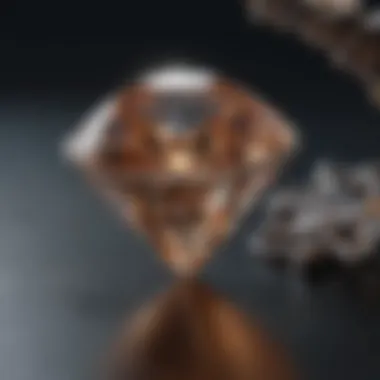
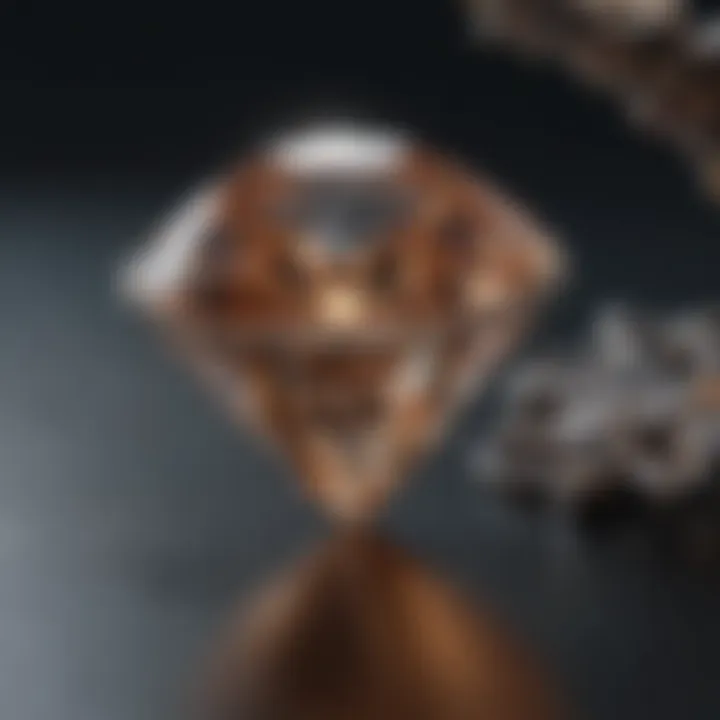
The late 1930s saw a significant marketing push by De Beers, emphasizing the idea that “A diamond is forever.” This campaign effectively tied the emotional weight of commitment to the purchasing of diamond rings. As a result, diamond rings symbolized ultimate devotion and became a staple in proposals worldwide. Today, one carat diamond rings embody not only wealth and status but also a lasting commitment, becoming modern symbols of love that have evolved from their ancient counterparts.
Understanding Carat Weight
Carat weight is a significant factor when evaluating diamonds, particularly one carat diamond rings. It not only influences the physical appearance of the stone but also affects its price and overall market value. In jewelry, the term "carat" specifically refers to the weight of the diamond, with one carat equaling 200 milligrams. Knowing how carat weight works can help both collectors and casual buyers make informed decisions, especially in terms of budget and desired aesthetics.
Defining Carat Weight
Carat weight serves as a standard measuring unit for diamonds. Each diamond is graded by its weight, which is an essential aspect for determining its worth. A common misconception is that carat weight directly correlates to size. While there is some truth to this, the relationship is more complex than it appears. Different cuts can affect how a diamond looks visually, regardless of its carat weight. Thus, understanding the definition of carat weight is crucial for anyone seeking to purchase a one carat diamond ring.
Carat Weight vs. Size Perception
The perception of size in diamonds can be misleading. For instance, two diamonds weighing one carat may appear differently in size based on their cut, depth, and dimensions. A well-cut diamond often looks larger than a poorly cut diamond of the same carat weight. This discrepancy means that buyers must look beyond carat weight alone when selecting their perfect diamond.
Several factors contribute to size perception:
- Cut Quality: The way a diamond is cut can greatly influence how large it appears. A deeper or shallower cut can make a carat-weighted diamond look smaller or larger than expected.
- Shape: Different shapes offer varying surface areas. For example, a round diamond may appear smaller than a rectangular or oval shaped stone, even if they share the same carat weight.
- Surrounding Setting: The design of the ring can enhance or diminish the perceived size of the diamond. A halo setting might make a one-carat diamond look significantly larger.
In essence, when determining the desirability of a one carat diamond ring, consider both carat weight and how this weight translates into perceived size. Studying these aspects serves to enrich the buyer’s knowledge, ensuring a satisfying purchase.
The Four Cs of Diamonds
Understanding diamonds involves comprehending the fundamental aspects of the Four Cs: cut, color, clarity, and carat weight. These criteria are vital in determining the overall quality and desirability of diamonds. The Four Cs influence both aesthetic appeal and market value. Prospective buyers benefit from knowing these elements, as they enhance decision-making when selecting one carat diamond rings.
Cut Quality
The cut of a diamond greatly affects its brilliance and sparkle. When we talk about cut quality, we refer to how well the diamond has been shaped and faceted. It’s not just about the shape, such as round or princess; it’s about the angles and proportions that create light reflection.
A well-cut diamond will display maximum brilliance. Poorly cut diamonds can look dull, even if they have high carat weight. Factors such as symmetry, polish, and proportion come into play. For buyers, this means always considering cut quality when evaluating a diamond. They should strive to balance cut with other Cs to ensure a sparkling piece.
Color Grades
Color in diamonds refers to the absence of color. High-quality diamonds, especially those in engagement rings, appear colorless. The Gemological Institute of America (GIA) uses a grading scale from D (colorless) to Z (light yellow). The less color a diamond has, the more valuable it is deemed.
While some buyers may prefer diamonds with a slight hue, understanding the full color spectrum allows for informed choices. For example, one carat diamonds with near-colorless grades (G, H, and I) offer a good balance of affordability and visual appeal.
Clarity Ratings
Clarity evaluates how free a diamond is from inclusions and blemishes. The GIA uses a scale from Flawless (no inclusions visible under 10x magnification) to Included (inclusions visible to the naked eye). Even a small inclusion can impact a diamond's overall look and value.
When purchasing, it is essential to consider clarity ratings. Some buyers might prioritize a higher clarity level, while others may choose a lower-grade diamond that appears stunning due to a perfect cut. Each choice reflects personal preference and budget considerations.
Carat Weight Impact
Carat weight measures the size of the diamond. One carat equals 200 milligrams, and although larger diamonds are undeniably desirable, carat weight alone does not determine a diamond's overall beauty or worth. A one carat diamond can appear smaller or larger based on its cut and other Cs.
For buyers, understanding carat weight is crucial. Choosing a diamond should involve evaluating how it fits within the context of the Four Cs collectively. Opting for a well-cut, high-color diamond may produce a more impactful look than merely choosing a higher carat weight with lower quality.
In summary, the Four Cs are essential in determining the quality and value of one carat diamond rings. Each element influences decisions, and knowing how they interlink can enhance understanding during the purchasing process.
Choosing the Right One Carat Diamond
Choosing the right one carat diamond is crucial for a number of reasons, particularly given the personal and financial investment it represents. Understanding this process is not just beneficial but essential for anyone seeking to acquire a meaningful piece of jewelry. A one carat diamond ring often symbolizes significant life events such as engagements or anniversaries. Therefore, the decision should be thoughtful and well-informed, taking into account various factors that can impact both value and personal satisfaction.
Setting a Budget
Establishing a budget is one of the first steps in choosing a one carat diamond. The price range for these diamonds can vary greatly depending on quality factors such as cut, color, and clarity. By defining a budget upfront, buyers can streamline their search, avoiding the frustration of falling in love with a diamond that is beyond their means. Furthermore, a budget helps prioritize which factors are most important to the buyer, whether it is a higher quality diamond or a more elaborate setting.
Certified vs. Non-Certified Diamonds
Another important consideration is whether to purchase a certified or non-certified diamond. Certified diamonds come with a grading report from a reputable gemological laboratory, such as the Gemological Institute of America (GIA). This document provides detailed information about the diamond's characteristics and ensures that you are paying for what you are actually getting. Non-certified diamonds often lack this transparency, potentially leading to questions about value and quality. Buyers should consider the peace of mind that comes from investing in a certified diamond, especially in an online market where visual inspection is not possible.
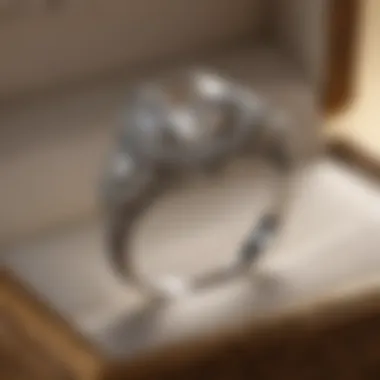
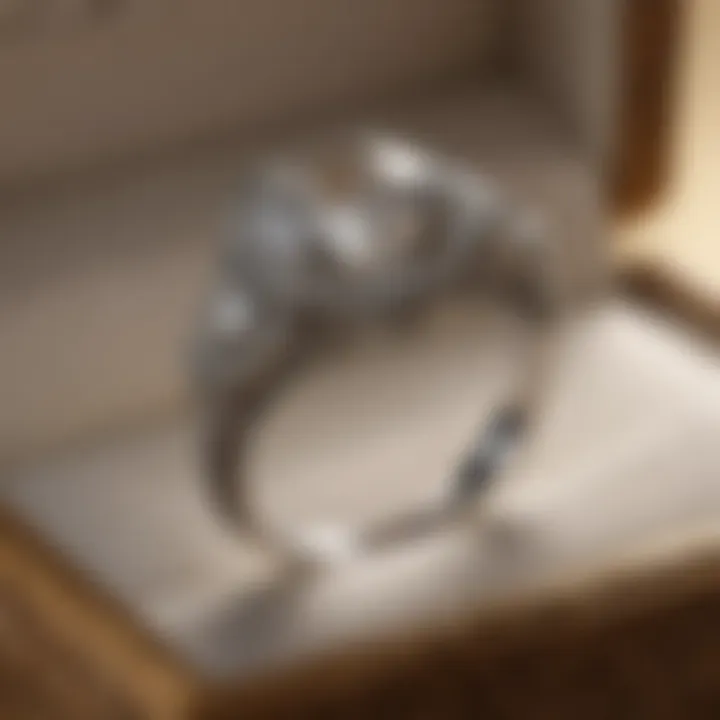
Shopping Tips
When shopping for a one carat diamond, knowledge is power. Here are several tips to consider:
- Research and Compare: Use online platforms to research different retailers. Websites like en.wikipedia.org or britannica.com can provide insights into the diamond market and specific vendors.
- Ask Questions: Don’t hesitate to ask jewelers questions about their diamonds, certifications, and return policies.
- Consider the Setting: Sometimes, a less expensive diamond can look stunning in a beautiful setting. This can allow buyers to allocate their budget more effectively.
- Timing Your Purchase: Certain times of the year, like holiday seasons or sales events, may offer better pricing on diamonds.
An educated buyer is often a more satisfied buyer. Understanding the nuances of diamond purchasing can improve your experience and the quality of your resulting investment.
Popular Settings for One Carat Diamonds
The selection of a setting for a one carat diamond holds significant importance in the overall aesthetic and symbolism of the ring. A well-chosen setting not only enhances the beauty of the diamond but also reflects the wearer's personal style. It can dramatically influence how the diamond's attributes, such as its brilliance and clarity, are perceived. Furthermore, the setting adds emotional weight to the piece, often symbolizing commitment and love.
When considering a one carat diamond ring, comprehending the various setting options available is crucial. Each setting comes with unique benefits and potential drawbacks, tailored for different styles and preferences. Understanding these distinctions allows individuals to make informed choices that align with their values and desires.
Solitaire Settings
The classic solitaire setting is often the most recognized option for one carat diamonds. This design features a single diamond mounted on a delicate band, emphasizing the stone itself. The brilliance of the diamond becomes the focal point, allowing its clarity and cut to shine without distraction.
Benefits of solitaire settings include:
- Timeless Appeal: Their simplicity provides a timeless elegance that has remained popular across generations.
- Versatility: Solitaire settings can be adapted to various styles through different band materials or finishes.
- Ease of Resizing: The minimal design allows for simpler resizing compared to more intricate settings.
However, potential drawbacks exist. For example, the exposed diamond may be more vulnerable to scratches or damage. Careful attention should be given to the diamond's quality and the setting’s durability.
Halo Designs
Halo settings have gained traction in recent years due to their captivating appearance. In this style, a center one carat diamond is surrounded by a ring of smaller stones, often enhancing the diamond's perceived size and sparkle.
Advantages of choosing a halo design include:
- Enhanced Sparkle: The surrounding stones reflect light, amplifying the brilliance and creating a captivating display.
- Perceived Size Increase: The halo creates an illusion of a larger diamond, which can be appealing for those seeking a bolder look.
- Customization Options: Halo settings can feature variations in stone quality and design, allowing for personalized styles.
However, they may require more upkeep due to the increased number of stones. Regular maintenance ensures that each smaller diamond remains secure and sparkly.
Three Stone Rings
Three stone settings symbolize the past, present, and future. This style typically features a one carat diamond in the center, flanked by two smaller stones on either side. This arrangement imparts a sense of balance and narrative to the ring.
Key characteristics of three stone rings include:
- Symbolic Meaning: Each stone signifies a different aspect of a relationship, adding sentimental value.
- Balanced Aesthetics: The arrangement delivers a visually balanced look that can complement various hand shapes.
- Multiple Stone Options: Different stones can be used alongside the main diamond, allowing for unique combinations and color accents.
Yet, this design can come with a higher price tag due to the additional stones involved, and resizing may be more complicated.
Choosing the right setting is an integral part of purchasing a one carat diamond. Each option offers distinct advantages and should be selected based on personal taste and the emotional significance of the piece.
Caring for Your One Carat Diamond Ring
Caring for a one carat diamond ring is essential for maintaining its beauty and longevity. Diamonds are known for their hardness, yet they can still be susceptible to dirt, damage, and wear over time. Proper care not only enhances the ring's appearance but also preserves its value. By taking steps to clean, store, and insure your diamond ring, you can ensure it remains a cherished piece for years to come.
Regular Cleaning Techniques
Keeping your diamond ring clean is one of the most effective ways to highlight its brilliance. Regular exposure to lotions, oils, and dirt can dull its sparkle. Simple cleaning techniques include:
- Warm Soapy Water: Soak the ring in a solution of mild dish soap and warm water for about 20-30 minutes. Use a soft toothbrush to gently scrub the diamond and the setting, paying special attention to hard-to-reach areas.
- Professional Cleaning: Having the ring professionally cleaned once a year can remove buildups that at-home methods might miss.
- Avoid Harsh Chemicals: Products containing bleach or chlorine can harm the metal or stone. Stick to gentle cleaners designed for jewelry.
Storing Your Diamond Safely
Proper storage prevents scratches and damage from other jewelry pieces. For one carat diamond rings, consider these storage options:
- Individual Boxes: Store the ring in its own soft pouch or box to avoid contact with other jewelry.
- Jewelry Organizer: A dedicated jewelry organizer with compartments can keep your ring separate from other pieces.
- Avoid Humidity: Keep your diamond in a cool, dry place away from direct sunlight. Excessive humidity can lead to tarnish on metal settings.
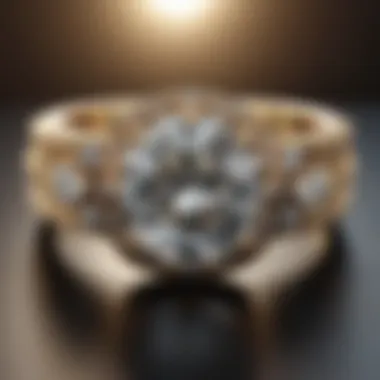
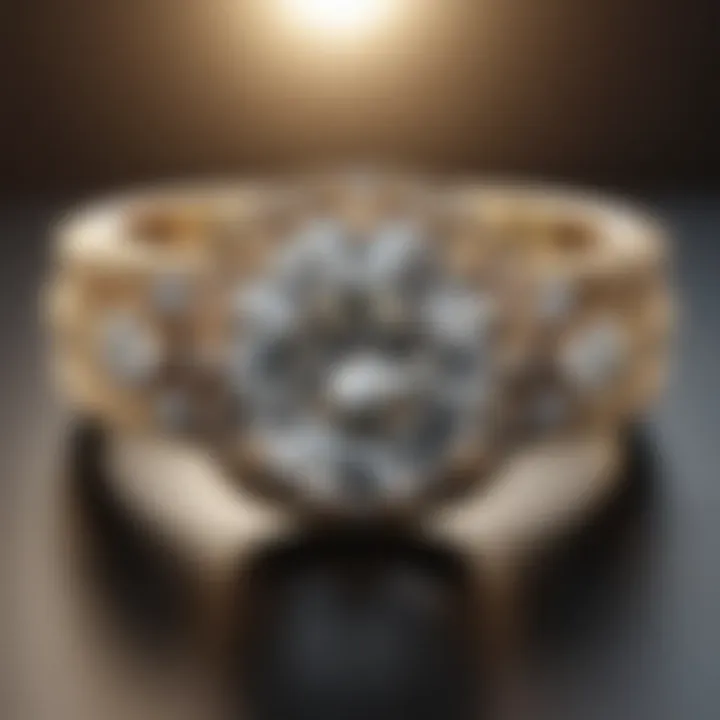
Insurance Considerations
Investing in insurance for your one carat diamond ring provides peace of mind. If the ring is lost, stolen, or damaged, having insurance can help mitigate financial loss. When considering insurance:
- Appraisal: Have your ring appraised by a certified gemologist to determine its value. This ensures you have adequate coverage.
- Review Policies: Look into specific jewelry policies or endorsements on homeowner's insurance that cover loss, theft, or damage. Different policies have varying terms, so it's crucial to understand them.
- Regular Checks: Periodically review and update your policy to reflect changes in value or condition.
Protecting your one carat diamond ring involves more than just aesthetics. It extends to financial considerations and ensuring the ring remains a valued possession.
Cultural Significance of Diamond Rings
Diamond rings, particularly one carat ones, reflect not just elegance but also deep-rooted cultural values. Their significance transcends mere adornment. A diamond ring often serves as a symbol of love and commitment. It marks milestones and celebrations of union between partners. Different cultures have unique interpretations and rituals associated with these rings, making them integral to various ceremonies and beliefs.
Understanding the cultural significance of diamond rings allows individuals to appreciate the cultural narrative behind the gemstone. This knowledge can enhance the emotional connection to jewelry, turning a simple purchase into a meaningful treasure. Additionally, diamond rings can also be collectible items. For collectors, the cultural stories behind these pieces can add considerable value.
Symbolism in Different Cultures
Across the globe, diamond rings possess various symbolic meanings. In Western cultures, diamonds are typically associated with engagement and marriage. The tradition of giving diamond rings dates back to the 15th century, inspired by the belief that diamonds represent eternal love. This idea has persisted, reinforcing the notion of steadfastness and commitment in relationships.
In other cultures, the significance of diamonds may differ. For instance, in Hindu culture, diamonds are often seen as a symbol of wealth and status. They are used in ceremonial jewelry for festive occasions. Additionally, diamonds carry astrological significance in Vedic astrology, believed to bring prosperity and success when worn in certain ways.
"Diamonds are not only beautiful jewels but also have rich stories woven through cultures and traditions."
In certain African cultures, diamonds are highly valued for their beauty and rarity. They may represent personal achievements or serve as heirlooms passed down through generations, marking familial bonds and histories. This combined perspective on symbolism enhances the diamond ring’s appeal.
Modern Trends in Engagement Rings
In contemporary society, engagement rings, especially those featuring one carat diamonds, showcase evolving trends influenced by changing societal norms and values. There is a noticeable shift toward personalization and individuality in ring design. Many couples now seek unique settings and stones that reflect their personal style and story.
Several trends have emerged:
- Vintage-Inspired Designs: Many gravitate towards vintage aesthetics, looking for rings that feature intricate detailing and historical provenance.
- Colored Gemstones: There is a growing interest in colored diamonds and alternative gemstones like sapphires or emeralds, offering a distinctive flair.
- Sustainable Choices: Eco-conscious consumers prioritize ethically sourced diamonds, leading to increased demand for lab-grown diamonds and recycled materials.
In the context of symbolism, modern engagement rings also embrace dual meanings. They may reflect commitment while emphasizing personal identity. As a result, each one carat diamond ring becomes a unique story, encompassing aspects of contemporary life and love.
By examining the cultural significance of diamond rings, individuals can better understand and appreciate their choice in this exquisite jewelry. This appreciation ultimately adds depth to the experience of purchasing or gifting a diamond ring.
Investment Value of One Carat Diamonds
Market Trends
Current market trends indicate a dynamic landscape for diamond investment. Over the past few years, the demand for high-quality diamonds, especially those in the one carat range, has seen notable fluctuations. It is vital to observe trends involving consumer preferences, economic conditions, and cultural shifts that influence buying behavior.
- Rising Demand: There's a growing appetite for diamonds as symbols of personal achievement, not just engagement. This trend underpins the increase in market value.
- Digital Influence: Online platforms have made access to information about diamonds easier. An increase in educated consumers has led to a push for ethically sourced and certified diamonds.
- Price Stability: Historically, one carat diamonds have shown resilience against economic downturns. However, this is contingent on various economic indicators such as inflation and consumer confidence.
The interplay of these factors creates a complex but fascinating market for potential investors. Thus, understanding market trends not only helps in evaluating the diamond but also in timing the purchase for maximum benefit.
Factors Affecting Value
The valuation of one carat diamonds is subject to several critical factors, each contributing uniquely to its overall worth. Individuals interested in investing should take these elements into account:
- The Four Cs: The cut, color, clarity, and carat weight collectively determine a diamond's quality. Higher grades in these categories generally correlate with increased value.
- Certification: Diamonds from reputable organizations, such as the Gemological Institute of America, tend to retain higher resale values due to established credibility.
- Market Conditions: Economic variables can cause price volatility. For instance, during economic booms, luxury items tend to increase in demand, thus enhancing value.
- Rarity and Scarcity: Not all diamonds are created equal. Some unique characteristics, such as fancy colors or exceptional clarity, make certain stones more desirable, affecting their value.
In summary, understanding the investment value of one carat diamonds is key for enthusiasts and collectors alike. Being well-informed about market trends and the influencing factors can lead to better decision-making. This ensures that when purchasing, the appeals to both aesthetic and financial considerations are met.
Ending
In wrapping up our exploration of one carat diamond rings, it’s essential to reflect on their enduring appeal. These rings are more than just pieces of jewelry; they embody significant cultural, emotional, and financial values. Their historical significance is seen in how diamonds have transcended time, becoming central figures in expressions of love and commitment.
For enthusiasts and collectors alike, understanding the factors that contribute to a diamond's allure enhances not only their appreciation but also their decision-making when purchasing. The four Cs—cut, color, clarity, and carat—remain vital for discerning quality and value, allowing buyers to select based on personal preferences and budget constraints.
Moreover, recognizing the diverse settings enhances the visual impact and personal expression offered by a one carat diamond ring. Each style, from solitaires to three-stone rings, tells a unique story, catering to various tastes and occasions. Caring for these rings also requires attentiveness, ensuring their beauty remains intact for generations.
Investing in a one carat diamond goes beyond mere ownership. It serves as a testament to enduring relationships and cherished moments. Given the current market trends, comprehending the elements that affect a diamond's value is crucial for those considering them an investment.
Ultimately, the journey through the world of one carat diamond rings is marked by a blend of historical context, personal sentiment, and the pursuit of beauty. This reflective understanding emphasizes why such rings retain their allure throughout the ages, forever serving as timeless symbols of love and commitment.
"A diamond is forever," a phrase that not only encompasses the resilience of the gemstone but also its lasting significance in human relationships.



